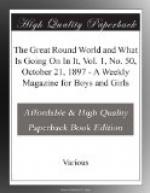“OLD MOTHER EARTH,” by Josephine Simpson and “THE STORY OF WASHINGTON,” by Jessie R. Smith.
The first-named book is without doubt one of the very best in its line. It adopts a simple, direct, natural way of unfolding the subject, and cannot fail to interest the children in all they see around them.
The “Story of Washington” is a little gem. The children would be delighted to read it for themselves, and the illustrations are such that children understand. It is beautifully bound for such a cheap little book, and surely ought to find favor wherever it is carefully examined.
INVENTION AND DISCOVERY.
TYPEWRITER FOR BOOKS.—We have for years had typewriters that would write on loose pages of paper, but the making of a perfect machine that could write in bound volumes has not been successfully accomplished until the present time.
A typewriting machine can write much more quickly than any penman—and the work it does has the advantage of being easy to read, whereas very few people write a clear and legible hand.
In office work much of the writing to be done is making entries in books and copying into ledgers.
All this has had to be done by hand, and it has of course taken a much longer time to do.
By means of this new invention books can be kept and entries copied with the same neatness and speed of an ordinary typewriter.
The great difficulty in making a machine to do this work properly was that it was not possible to have the paper move back and forth as it does in typewriting machines generally. For bound books the paper must remain still, and the type moves over the page in the same manner that the pen does.
The new book typewriter has mastered this difficulty. The page is held firmly in a kind of frame, and the type moves with each letter or word that it writes.
In making entries in books, it is highly necessary to be sure that the writing is correct—and so this machine has a simple little device which lifts the type up and shows the writing underneath.



